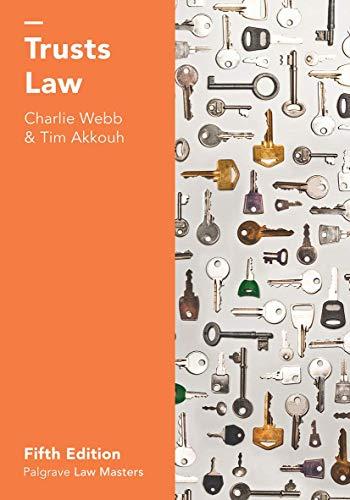Question
Submit a 3C+Q response to the following discussion: Compliment: Connect: Comment: Question: Chapter 13 Case Study: Doing the Right Thing (p. 318). The case of
Submit a 3C+Q response to the following discussion:
Compliment:
Connect:
Comment:
Question:
Chapter 13 Case Study: Doing the Right Thing (p. 318).
The case of Justin Hopson and his experiences with the New Jersey State Troopers provides a rounded example of the complex ethical landscape within certain work cultures, especially in organizations with strict hierarchical structures and strong internal codes of conduct. Let's explore the questions established in relation to values, morals, and ethics. According to Guy & Ely (2022, p.333), the foundation of core values begins with personal standards, alongside integrity and honesty. These values are essential in any workplace, setting the tone for a culture of trust, responsibility, and ethical behavior. In the realm of law enforcement, where officers are entrusted with great power and responsibility, adhering to these values is not just importantit's imperative. Law enforcement officers act as guardians of societal norms and laws, making their commitment to integrity and honesty crucial in maintaining public trust and justice. By upholding these personal standards, officers not only enhance their own moral compass but also contribute to a positive and ethical organizational culture. This commitment ensures that their actions align with the principles of fairness, justice, and respect for all individuals, reinforcing the idea that ethical behavior is the cornerstone of effective and honorable law enforcement.
- Why does doing the right thing bring scorn and harassment when the norms of a work culture support unethical behavior?
Group Cohesion vs. Individual Morality: In organizations where, unethical behaviors have become normalized, group cohesion is often prioritized over individual moral judgments. Members who challenge these norms threaten not only the status quo but also the apparent unity and strength of the group. This can lead to rejection and harassment as a means of 'correcting' or blackballing the opposing individual to maintain cohesion and conformity.
Fear of Exposure and Accountability: When a culture is submerged in unethical practices, individuals who act ethically pose a threat of exposing these practices to external scrutiny. This fear of exposure and the potential for accountability and repercussions can drive those involved in unethical behavior to silence opposing voices aggressively.
Power Dynamics and Control: Unethical work cultures often rely on strict power dynamics and control methods to operate. Individuals like Justin Hopson, who act according to their moral compass, challenge these power structures. In response, those in power may use scorn and harassment as tools to reassert control and discourage others from similar acts of dissent.
- What are the ethical issues in this case?
Abuse of Power: The behavior of the "Lords of Discipline" represents a clear abuse of power. Instead of upholding justice and integrity, they used their positions to perpetrate and cover up misconduct, demonstrating a profound disregard for ethical policing and the rule of law.
Retaliation against Whistleblowers: The harassment faced by Hopson for refusing to support an unlawful charge and for reporting unethical behavior is a significant ethical issue. It highlights the dangers faced by whistleblowers in environments where corruption is widespread, and it raises questions about the protection and support systems available for those who expose wrongdoing. Guy & Ely (2022, p. 336) highlighted that whistleblowing exposes establishments or individuals to scrutiny that they would rather avoid. Moreover, it can undermine the overall integrity of a department. Whistleblowing acts as a beacon, revealing misconduct or ethical lapses that, while uncomfortable, prompts necessary introspection and reform. It brings to the forefront the importance of accountability and transparency within organizations. While the immediate effects might seem detrimental, highlighting weaknesses and failures, this process is vital for fostering a culture of integrity and trust. By addressing these issues head-on, departments can strengthen their ethical foundations and rebuild public confidence.
Corruption and Misconduct: The fabrication of charges against an innocent individual and the subsequent campaign of intimidation against Hopson underline the ethical issue of corruption and misconduct within the force. These actions betray the trust placed in law enforcement to act fairly, justly, and within the bounds of the law.
Compromised Integrity of Law Enforcement: The main ethical concern in this case is the compromised integrity of the law enforcement institution. When officers tasked with upholding the law engage in unethical behavior and support a culture that condones such actions, it weakens public trust and the very foundations of justice and accountability.
The case of Justin Hopson and the "Lords of Discipline" underlines the critical importance of ethical leadership, transparency, and accountability in maintaining the moral integrity of any organization, particularly those entrusted with public safety and justice.
References:
Guy, M. E., & Ely, T. L. (2022). Essentials of Public Service: An introduction to contemporary public administration (2nd ed.). Melvin & Leigh, Publishers.
Step by Step Solution
There are 3 Steps involved in it
Step: 1

Get Instant Access to Expert-Tailored Solutions
See step-by-step solutions with expert insights and AI powered tools for academic success
Step: 2

Step: 3

Ace Your Homework with AI
Get the answers you need in no time with our AI-driven, step-by-step assistance
Get Started


